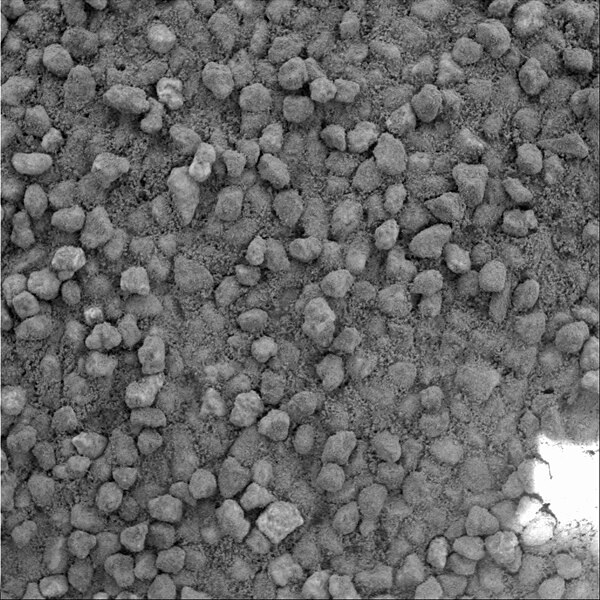File:MER Cliffhanger sand.jpg

Original file (1,024 × 1,024 pixels, file size: 741 KB, MIME type: image/jpeg)
Captions
Captions
Summary edit
| DescriptionMER Cliffhanger sand.jpg |
English: Original caption: A basic tenet of sedimentology, the field of geology that studies sedimentary processes, is that the farther a piece of rock travels from its source, the smaller and rounder in shape it becomes as the materials suffer impacts with other grains during transport by wind or water. Grains that have not traveled as far are more angular and less rounded. A comparison of photographs taken by the microscopic imager on NASA's Mars Exploration Rover Spirit suggests that sand that has accumulated in drifts on the plains of Gusev Crater traveled farther from the source rock than similar sand grains in the hills inside Gusev. In a microscopic image taken on the plains of Gusev Crater early in the mission , sand deposits were made up of rounded grains. In contrast, this more recent microscopic image of a sand drift near the top of the "Columbia Hills" shows poorly sorted, more angular grains of sand, which suggests they were transported a relatively short distance from a local source.
This image is of grains in a sand drift informally named "Cliffhanger" because of its proximity to the edge of steep slopes that bound the summit region of "Husband Hill," highest of the Columbia Hills. Spirit took the image with its microscopic imager on the rover's 607th martian day, or sol (Sept. 9, 2005). The photo covers an area 3 centimeters (1.2 inches) across. The scale of the image (31 microns or one one-thousandth of an inch per pixel) allows features as small as 0.1 millimeter (four one-thousandths of an inch) to be resolved. |
| Date | |
| Source | http://marsrovers.jpl.nasa.gov/gallery/press/spirit/20050930a.html |
| Author | NASA/JPL-Caltech/Cornell/USGS |
| Permission (Reusing this file) |
Original work of NASA - public domain |
| Other versions | File:PIA06410-Spirit_Rover-Cliffhanger_Sand.png |
This image or video was catalogued by Jet Propulsion Laboratory of the United States National Aeronautics and Space Administration (NASA) under Photo ID: PIA06410 and Alternate ID: 2M180252213EFFAEM9P2977M2M1. This tag does not indicate the copyright status of the attached work. A normal copyright tag is still required. See Commons:Licensing. Other languages:
العربية ∙ беларуская (тарашкевіца) ∙ български ∙ català ∙ čeština ∙ dansk ∙ Deutsch ∙ English ∙ español ∙ فارسی ∙ français ∙ galego ∙ magyar ∙ հայերեն ∙ Bahasa Indonesia ∙ italiano ∙ 日本語 ∙ македонски ∙ മലയാളം ∙ Nederlands ∙ polski ∙ português ∙ русский ∙ sicilianu ∙ slovenščina ∙ Türkçe ∙ українська ∙ 简体中文 ∙ 繁體中文 ∙ +/− |
Licensing edit
| Public domainPublic domainfalsefalse |
| This file is in the public domain in the United States because it was solely created by NASA. NASA copyright policy states that "NASA material is not protected by copyright unless noted". (See Template:PD-USGov, NASA copyright policy page or JPL Image Use Policy.) |  | |
 |
Warnings:
|
File history
Click on a date/time to view the file as it appeared at that time.
| Date/Time | Thumbnail | Dimensions | User | Comment | |
|---|---|---|---|---|---|
| current | 06:45, 22 April 2011 |  | 1,024 × 1,024 (741 KB) | Tony Wills (talk | contribs) | ==Summary== {{Information |Description={{Original caption|A basic tenet of sedimentology, the field of geology that studies sedimentary processes, is that the farther a piece of rock travels from its source, the smaller and rounder in shape it becomes as |
You cannot overwrite this file.
File usage on Commons
The following 3 pages use this file:
File usage on other wikis
The following other wikis use this file:
- Usage on he.wikipedia.org
- Usage on ja.wikipedia.org
Metadata
This file contains additional information such as Exif metadata which may have been added by the digital camera, scanner, or software program used to create or digitize it. If the file has been modified from its original state, some details such as the timestamp may not fully reflect those of the original file. The timestamp is only as accurate as the clock in the camera, and it may be completely wrong.
| Orientation | Normal |
|---|---|
| Horizontal resolution | 72 dpi |
| Vertical resolution | 72 dpi |
| Software used | Adobe Photoshop CS Macintosh |
| File change date and time | 14:01, 27 September 2005 |
| Color space | Uncalibrated |
| Image width | 1,024 px |
| Image height | 1,024 px |
| Date and time of digitizing | 07:01, 27 September 2005 |
| Date metadata was last modified | 07:01, 27 September 2005 |